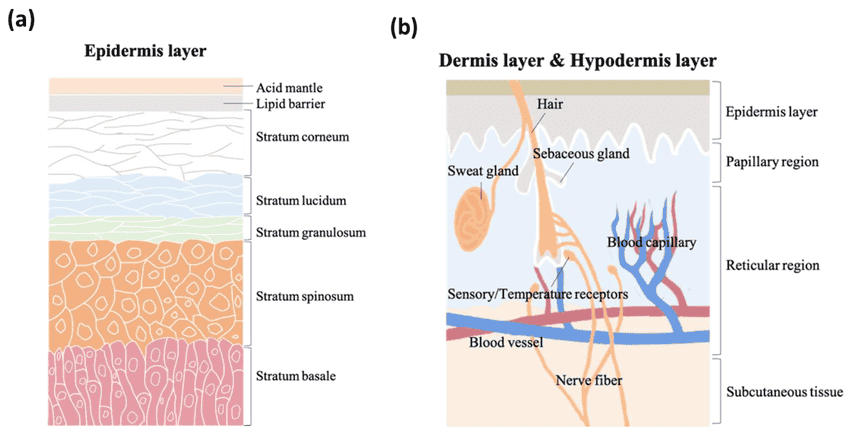Understanding the Skin Barrier: How to Care for Your Body’s Largest Organ
Guest Author: Magic Keller — 11/14/25
Introduction
Acidic, porous, and selectively permeable, oh my! Our skin is our largest organ by far, and this marvelous body system works to ensure our vibrant health. Its layered structure provides a beautiful boundary between what you usually think of as “me” and “not me.”
With a balanced moisture barrier, our skin keeps us hydrated and wards off harmful substances. Using proper care, we maintain our skin function and promote a lovely glow. More about that below, but first, let’s take a closer look at the layers of our skin system.
Source: researchgate. schematic structure Epidermis, Dermis, & Hypodermis layer
Skin Anatomy
Our skin, also known as our integumentary system, is made up of three different layers. Each performs important roles in our overall health.
1. Subcutaneous Layer (Hypodermis)
Starting at the innermost layer, the subcutaneous layer is made up of fat and connective tissue. This layer:
Insulates us from the cold
Provides cushion
Stores energy
2. Dermis
Moving outward, we find the dermis — a thick layer containing two sublayers:
Papillary layer: rich with blood vessels
Reticular layer: contains nerve endings, allowing us to sense touch and temperature
The dermis helps us to:
Regulate body temperature
Bring in nutrients from the bloodstream
Carry away waste products
Provide elasticity and strength (hello collagen, elastin, and protein!)
Lubricate skin with sebaceous glands
3. Epidermis
Finally, we arrive at the part of our skin we are probably most familiar with: the epidermis. This outermost layer is dynamic — as new skin cells form, older ones are pushed to the surface and continuously sloughed off. This can happen at a rate of up to nine pounds per year!
In this layer, we find many different sublayers performing jobs like:
Protecting our body’s cells
Creating skin flexibility and strength
Dried Rose petals by Missouri Herbs
The Skin Barrier: Looking Closer
On the outermost surface of the epidermis lies the stratum corneum, aka the skin barrier. At the very surface of our barrier sits our acid mantle.
This slightly acidic film:
Prevents water loss from our skin
Protects us from external disruptions
Regulates inflammation
Supports structure and stability
The acid mantle’s ideal pH is 5.5. This is easily disrupted, which is why proper care is very important.
What does a healthy skin barrier look like?
You know it when you see it. Imagine healthy skin for a moment. You’ll probably picture a complexion that looks smooth, hydrated, clear, & even. This is a healthy skin barrier.
A compromised skin barrier may appear:
Dry
Flaky
Reddish
Inflamed
Yarrow in the rain by Missouri Herbs
Creating a Healthy Skin Barrier
At this point, you’re probably asking, “How do I create a healthy skin barrier?” Here are my tips from my own herbal practice:
Avoid stripping your skin of oils.
Overly-frequent washing and using harsh cleansers disrupts our skin barrier. Even a hot shower can damage the acid mantle by removing some of your skin’s protective oils. Use moderation in washing yourself, and limit your use of harsh soaps.Opt for oils-based cleansers.
All skin types can benefit from oils, which help keep the skin moist, support barrier function, and supply skin with nutrients like essential fatty acids and vitamins. Oil-based cleansers help remove dirt and debris from skin while supporting your acid mantle rather than disrupting it. I highly recommend the Herbal Face Cleanser from Missouri Herbs. This combination of sunflower seed and castor oils is incredibly soothing. The additional herbal powers of rose and yarrow complement these oils with their anti-inflammatory, anti-bacterial, and soothing properties. My skin has never felt softer!Avoid environmental toxin exposure.
This can include household detergents, fragrances, paints, etc. Investigating possible sensitivities and limiting exposure is a great supportive step for your skin barrier.Eat for healthy skin.
Food sensitivities often cause skin flare-ups and barrier disruptions. Personally I’ve seen skin challenges ranging from eczema to dandruff to acne to mild dry skin improve drastically by making dietary changes. Likewise, eating nutritious foods full of protein, fiber, vitamins, and minerals can support vibrant skin.Get dirty.
Recent studies have noted that short-term contact with soil and plant materials can have a positive effect on skin barrier health by increasing the diversity of our skin microbiome. A healthy skin microbiome has been associated with positive outcomes in cases of skin issues like eczema and psoriasis. Clinically, I have witnessed improvement in fungal infections as a result of increased direct soil contact.Care for damaged areas.
Acne, rashes, dry patches, and problem patches are all places where the skin barrier needs some extra TLC. On wet areas like a weepy rash or whiteheads, lighter preparations like herbal washes, sprays, and steams are helpful. On dry areas like flaky skin or cracked scabs, oil-based preparations like the Dry Itchy Skin Salve from Missouri Herbs are appropriate. In practice, I find the key is to match a problem area with what it needs. While salve might be too moistening on a weepy rash, it’s just right on your dry elbows!
Start by applying one or two of these tips and observing their effects. Watching your skin start to glow will be all the motivation you need to make additional changes!
Resources:
Here are a couple of places for further reading and more info on what’s discussed here.
Crash Course Anatomy & Physiology (look for the episodes on Tissues and the Integumentary System)
The Gift of Healing Herbs by Robin Rose Bennett
Author’s Bio:
Magic Keller has 10 years of training and experience in Traditional Western Herbalism and has learned from many herbalists around the country. A passionate teacher, Magic enjoys sharing the wonders of herbal medicine as a way to help people feel more empowered about their healthcare. Visit her website at: ozarksherbschool.com
Magic Keller of Ozarks Herb School





